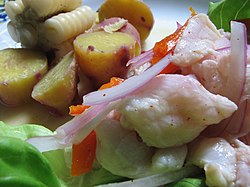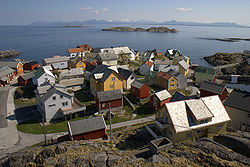- Huanchaco beach
surfer's paradise - Peruvian fishing boats
It shows the typical and ancient
caballitos de totora - Park in Huanchaco
Huanchaco | |
|---|---|
 From top and left to right: View of Huanchaco beach, Dish of cebiche, Huanchaco pier, Saveguard in Caballito de Totora, Tumi: Chimu work, Chan Chan: Chimu capital, Park in Huanchaco, Night view of the pier, Swamps of Huanchaco, Navegator Chimu in a Caballito de Totora, Surfers in Huanchaco, Wall in Chan Chan | |
| Coordinates: 7°42.0′S79°26.0′W / 7.7000°S 79.4333°W | |
| Country | |
| Region | La Libertad Region |
| Province | Trujillo |
| District | Huanchaco |
| Established | Mochica in Pre-Columbian era [1] Spanish: January 1, 1535 by fray Alonso de Escarcena and Juan de Barbaran. [1] |
| Government | |
| • Mayor | Jose Ruiz Vega (2019-2022) |
| Elevation | 13 m (43 ft) |
| Population (2017) | |
| • Urban | 71,379 |
| • Demonym | huanchaquino(a) huanchaqueño(a) |
| Time zone | UTC-5 (PET) |
| Website | Municipality of Huanchaco |
Huanchaco is a popular seaside resort city in province of Trujillo, Peru. [2] Huanchaco is known for its surf breaks, its caballitos de totora and its ceviche, and is near the ancient ruins of Chan Chan. Huanchaco was approved as a World Surfing Reserve by the organization Save The Waves Coalition in 2012 [3] This historic town is part of the tourist circuit called the "Moche Route" or "Ruta Moche". [4]
Contents
- History
- Pre-Columbian era
- Colonial era
- Origin of Ceviche
- Tourism
- Surfing
- Sandboarding
- Swamps of Huanchaco
- Festivals
- In popular culture
- See also
- References
- External links
- Multimedia
Scientific research on the maritime culture of Huanchaco has been conducted and published by American anthropologist Ricardo Sabogal-Suji, Ph.D. [5]
Dr. Ricardo Sabogal-Suji has investigated the significance of Huanchaco's historical, cultural, and touristic value. [6]











